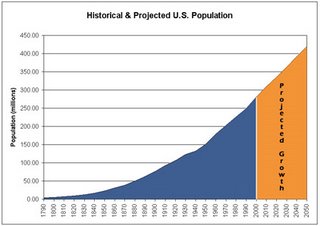 The United States, the only major industrial country whose population is substantially increasing, will reach the 300 million mark this month. The figure is significant as the States has the highest per capita environmental impact in the world, and that impact has risen dramatically in recent decades.
The United States, the only major industrial country whose population is substantially increasing, will reach the 300 million mark this month. The figure is significant as the States has the highest per capita environmental impact in the world, and that impact has risen dramatically in recent decades.
Conservative commentators will likely use this as a reason to argue for tighter immigration control. Immigration has indeed played a role in overall population growth; however, the vast majority of growth since 1960 is do to the high birth rate of the US - a statistic that conservative values have likely influenced by opposing sex education, abortion, and through overall economic policies that maintain a large discrepency in overall wealth.
At 2.1335 births per woman, the US fertility rate is the highest its been since 1971 and far exceeds other developed nations. The current US birth rate is 25% higher than the UK, 52% higher than Canada, and a whopping 64% higher than Germany's rate of 1.3%.
Here is the overview of environmental impact:
The US is the world's third most populous country, has the highest environmental impact, and is continuing to grow. In biological terms this is referred to as cancerous.- Each American occupies 20 percent more developed land - housing, schools, shopping and roads - than 20 years ago.
- Each American uses three times as much water as the world average; over half the original wetlands in the United States have been lost, mainly due to urban and suburban development and agriculture.
- Half the continental United States can no longer support its original vegetation; nearly 1,000 plant and animal species are listed by the U.S. government as endangered or threatened, with 85 percent of those due to habitat loss or alteration.
- The United States consumes nearly 25 percent of the world's energy, though it has only 5 percent of the world's population, and has the highest per capita oil consumption worldwide.
- Each American produces about 5 pounds (2.3 kilogram) of trash a day, up from about 3 pounds (1.4 kilogram) in 1960; the current rate is about five times that in developing countries.